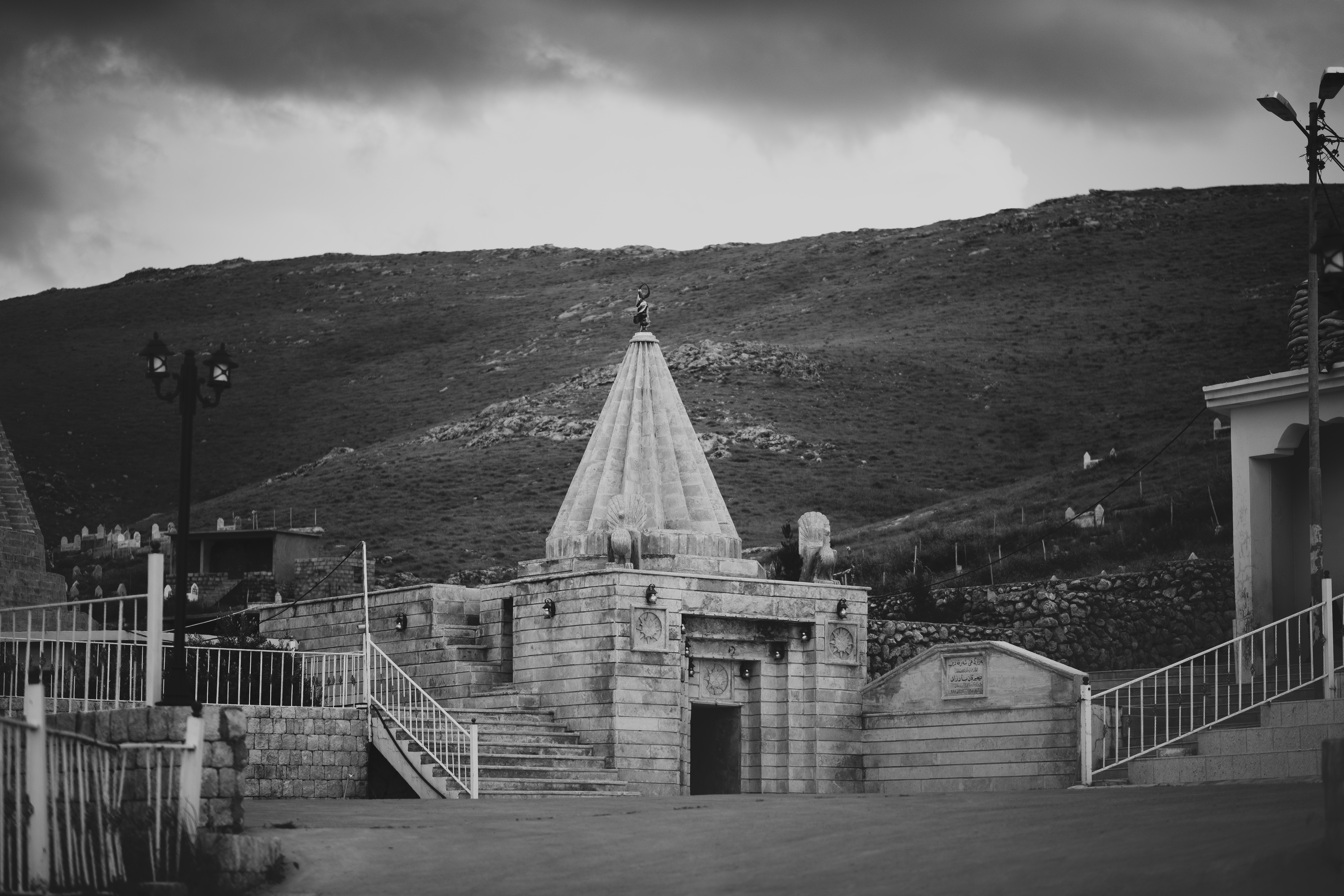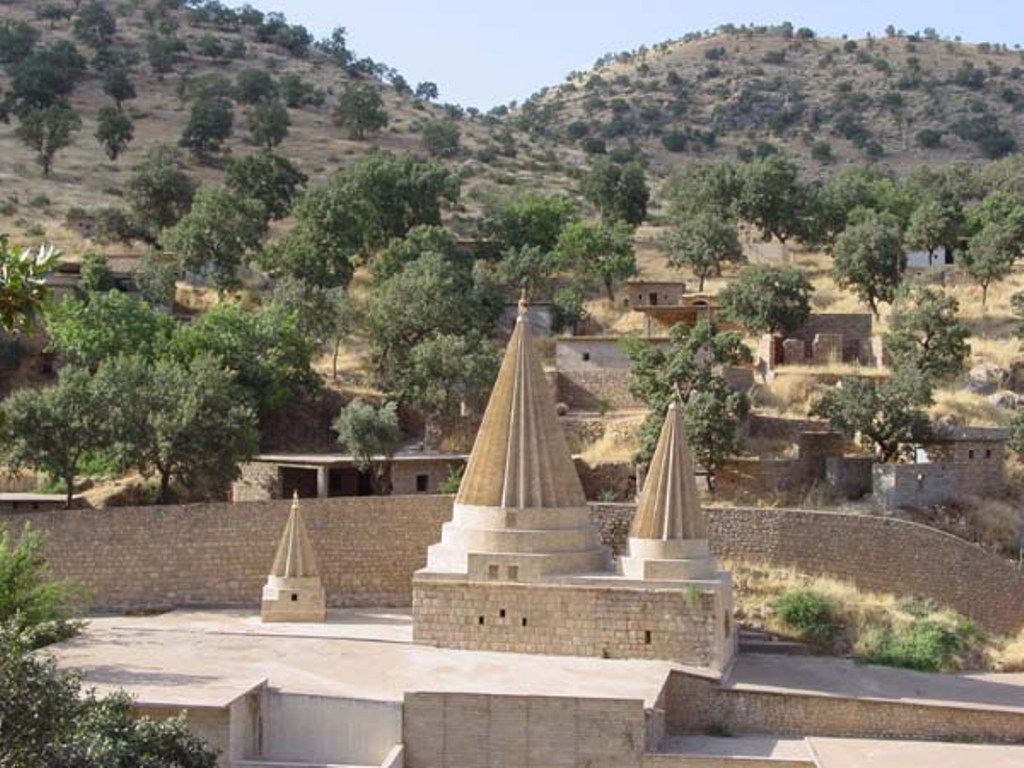|
Sharfadin
Sheikh Sharaf ad-Dīn ibn al-Hasan () was the son and religious heir of al-Hasan ibn ‘Adī and thus head of the ‘Adawiyya order. He died in battle against the Mongols in 1258 and was succeeded by his uncle, Fakhr ad-Dīn ibn ‘Adī. Due to the hostility of the Mongols, his son Zayn ed Din preferred not to become his successor and passed on the duties to Fakhr ad-Dīn ibn ‘Adī, who was married to a Mongol. The Sherfedin sanctuary is considered to be one of the oldest and most important Yazidi holy sites. Sherfedin is particularly revered in the Sinjar region. The Yazidi ''Qewlê Şerfedîn'' ("Hymn of Şerfedîn") identifies Şerfedîn with the Mahdi. In the hymn (''qewl''), Şerfedîn is currently staying in a cave and will emerge at the end of times. See also *List of Yazidi holy figures *List of Yazidi holy places *Sharfadin Temple The Sharfadin temple in Sinjar, Iraq is an 800-year old Yazidi temple built in honor of Sheikh Sherfedin. It is considered by Yaz ... [...More Info...] [...Related Items...] OR: [Wikipedia] [Google] [Baidu] |
Sharfadin Temple
The Sharfadin temple in Sinjar, Iraq is an 800-year old Yazidi temple built in honor of Sheikh Sherfedin. It is considered by Yazidis as one of the holiest places on earth. The temple is made of a pale yellow stone, with two cones atop the building. At the tip of each cone are three gold balls and a crescent reaching skyward. In August 2014, the temple was the site of a battle where 18 lightly armed Yazidi Peshmerga fighters under the command of Qasim Shesho successfully held off a larger and better equipped ISIL force with armored vehicles, mortars, and rockets that had attacked the shrine as part of the Genocide of Yazidis by ISIL. See also *List of Yazidi holy places References {{Reflist Yazidi holy places ... [...More Info...] [...Related Items...] OR: [Wikipedia] [Google] [Baidu] |
Yazidi Mythology
Yazidis or Yezidis (; ku, ئێزیدی, translit=Êzidî) are a Kurmanji-speaking endogamous minority group who are indigenous to Kurdistan, a geographical region in Western Asia that includes parts of Iraq, Syria, Turkey and Iran. The majority of Yazidis remaining in the Middle East today live in Iraq, primarily in the governorates of Nineveh and Duhok. There is a disagreement among scholars and in Yazidi circles on whether the Yazidi people are a distinct ethnoreligious group or a religious sub-group of the Kurds, an Iranic ethnic group. Yazidism is the ethnic religion of the Yazidi people and is monotheistic in nature, having roots in a pre-Zoroastrian Iranic faith. Since the spread of Islam began with the early Muslim conquests of the 7th–8th centuries, Yazidis have faced persecution by Arabs and later by Turks, as their religious practices have commonly been charged with heresy by Muslim clerics. Most recently, the 2014 Yazidi genocide that was carried out by th ... [...More Info...] [...Related Items...] OR: [Wikipedia] [Google] [Baidu] |
Ezidi Shrine Of Sharaf Al-Deen Nestled Into The Shingal Mountains Near Sinune Village 01
Yazidis or Yezidis (; ku, ئێزیدی, translit=Êzidî) are a Kurmanji-speaking Endogamy, endogamous minority group who are indigenous to Kurdistan, a geographical region in Western Asia that includes parts of Iraq, Syria, Turkey and Iran. The majority of Yazidis remaining in the Middle East today live in Iraq, primarily in the Governorates of Iraq, governorates of Nineveh Governorate, Nineveh and Duhok Governorate, Duhok. There is a disagreement among scholars and in Yazidi circles on whether the Yazidi people are a distinct ethnoreligious group or a religious sub-group of the Kurds, an Iranian peoples, Iranic ethnic group. Yazidism is the ethnic religion of the Yazidi people and is Monotheism, monotheistic in nature, having roots in a Ancient Iranian religion, pre-Zoroastrian Iranic faith. Since the spread of Islam began with the early Muslim conquests of the 7th–8th centuries, Persecution of Yazidis, Yazidis have faced persecution by Arabs and later by Turkish people, ... [...More Info...] [...Related Items...] OR: [Wikipedia] [Google] [Baidu] |
List Of Yazidi Holy Places ...
This is a list of Yazidi temples across the world. Background Yazidis are an ethnoreligious group who live predominantly in northern Iraq. Their religion is known as Yazidism. List See also * List of Yazidi saints * List of Yazidi settlements * Yazidism * Yazidis References External links {{Commons category-inline * Yazidi Yazidi Yazidis or Yezidis (; ku, ئێزیدی, translit=Êzidî) are a Kurmanji-speaking endogamous minority group who are indigenous to Kurdistan, a geographical region in Western Asia that includes parts of Iraq, Syria, Turkey and Iran. The majo ... [...More Info...] [...Related Items...] OR: [Wikipedia] [Google] [Baidu] |
Al-Hasan Ibn Adi
Sheikh Hasan ibn Sheikh ‘Adī II () is a holy and historical figure in that is revered in Yazidism and considered the physical or earthly incarnation of Melik Şêxsin, one of the Seven Divine Beings to whom God assigned the World's affairs. Melik Şêxsin is associated with the Pen and consequently with writing and books, he is thus called Xudanê Qelemê (The Master of the Pen). Adani Sheikhs are the descendants of Sheikh Hasan and were traditionally the only ones in Yazidi society that had the privilege to acquire the art of writing and reading. Historical biography Şêx Hesen was the son of Sheikh Adi II, who was the son of Abu Sakhr ibn Barakat. The Yazidis enjoyed a widespread geographical and political authority during the reign of Şêx Hesen and under his term of office, traditional Kurdish beliefs and myths began to reassert themselves as part of the local religious tradition and eventually became an integral part of the community's culture. More significantly, the ... [...More Info...] [...Related Items...] OR: [Wikipedia] [Google] [Baidu] |
Yazidi Holy Sites ...
This is a list of Yazidi temples across the world. Background Yazidis are an ethnoreligious group who live predominantly in northern Iraq. Their religion is known as Yazidism. List See also * List of Yazidi saints * List of Yazidi settlements * Yazidism * Yazidis References External links {{Commons category-inline * Yazidi Yazidi Yazidis or Yezidis (; ku, ئێزیدی, translit=Êzidî) are a Kurmanji-speaking endogamous minority group who are indigenous to Kurdistan, a geographical region in Western Asia that includes parts of Iraq, Syria, Turkey and Iran. The ma ... [...More Info...] [...Related Items...] OR: [Wikipedia] [Google] [Baidu] |
Abbasid Dynasty
The Abbasid dynasty or Abbasids ( ar, بنو العباس, Banu al-ʿAbbās) were an Arab dynasty that ruled the Abbasid Caliphate between 750 and 1258. They were from the Qurayshi Hashimid clan of Banu Abbas, descended from Abbas ibn Abd al-Muttalib. The Abbasid Caliphate is divided into three main periods: Early Abbasid era (750–861), Middle Abbasid era (861–936) and Later Abbasid era (936–1258). A cadet branch of the dynasty also ruled as ceremonial rulers for the Mamluk Sultanate as Caliph (1261–1517), until their conquest by the Ottoman Empire. Ancestry The Abbasids descended from Abbas, one of Muhammad's companions (as well as his uncle) and one of the early Qur'an scholars. Therefore, their roots trace back to Hashim ibn 'Abd Manaf and also Adnan in the following line: Al-‘Abbas ibn Abdul-Muttalib ibn Hashim ibn Abd Manaf ibn Qusai ibn Kilab ibn Murrah ibn Ka'b ibn Lu'ay ibn Ghalib ibn Fihr ibn Malik ibn An-Nadr ibn Kinanah ibn Khuzaima ibn Mudrikah ibn Ily ... [...More Info...] [...Related Items...] OR: [Wikipedia] [Google] [Baidu] |
Year Of Birth Unknown
A year or annus is the orbital period of a planetary body, for example, the Earth, moving in its orbit around the Sun. Due to the Earth's axial tilt, the course of a year sees the passing of the seasons, marked by change in weather, the hours of daylight, and, consequently, vegetation and soil fertility. In temperate and subpolar regions around the planet, four seasons are generally recognized: spring, summer, autumn and winter. In tropical and subtropical regions, several geographical sectors do not present defined seasons; but in the seasonal tropics, the annual wet and dry seasons are recognized and tracked. A calendar year is an approximation of the number of days of the Earth's orbital period, as counted in a given calendar. The Gregorian calendar, or modern calendar, presents its calendar year to be either a common year of 365 days or a leap year of 366 days, as do the Julian calendars. For the Gregorian calendar, the average length of the calendar year ( ... [...More Info...] [...Related Items...] OR: [Wikipedia] [Google] [Baidu] |
1258 Deaths
1 (one, unit, unity) is a number representing a single or the only entity. 1 is also a numerical digit and represents a single unit of counting or measurement. For example, a line segment of ''unit length'' is a line segment of length 1. In conventions of sign where zero is considered neither positive nor negative, 1 is the first and smallest positive integer. It is also sometimes considered the first of the infinite sequence of natural numbers, followed by 2, although by other definitions 1 is the second natural number, following 0. The fundamental mathematical property of 1 is to be a multiplicative identity, meaning that any number multiplied by 1 equals the same number. Most if not all properties of 1 can be deduced from this. In advanced mathematics, a multiplicative identity is often denoted 1, even if it is not a number. 1 is by convention not considered a prime number; this was not universally accepted until the mid-20th century. Additionally, 1 is the s ... [...More Info...] [...Related Items...] OR: [Wikipedia] [Google] [Baidu] |
Mahdi
The Mahdi ( ar, ٱلْمَهْدِيّ, al-Mahdī, lit=the Guided) is a Messianism, messianic figure in Islamic eschatology who is believed to appear at the Eschatology, end of times to rid the world of evil and injustice. He is said to be a descendant of Muhammad who will appear shortly before the Prophets in Islam, prophet Jesus in Islam, ʿĪsā (Jesus) and lead Muslims to rule the world. Though the Mahdi is not referenced in the Quran, and is absent from several List of hadith Books, canonical compilations of hadith – including the two most-revered Sunni hadith collections: ''Sahih al-Bukhari'' and ''Sahih Muslim'' – he is mentioned in other Hadith, hadith literature. The doctrine of the mahdi seems to have gained traction during the confusion and unrest of the religious and political upheavals of the first and second centuries of Islam. Among the first references to the Mahdi appear in the late 7th century, when the revolutionary Mukhtar al-Thaqafi, Mukhtar ibn Abi Uba ... [...More Info...] [...Related Items...] OR: [Wikipedia] [Google] [Baidu] |
List Of Yazidi Holy Figures
This is a list of holy figures () in Yazidism. There are a total of 365 Yazidi holy figures venerated by Yazidis. Many Yazidi tribes and lineages are named after Yazidi holy figures and there are many temples and shrines built in their honor. Holy figures in Yazidism are designated by various special terms including ''Babçak'', ''Xudan'' (lord, master, owner, holder, proprietor, protector, deity), ''Xas'' (selected, notable, special, elite) and ''Mêr'' which translates to (holy) man. According to Yazidi belief God is almighty and absolute, and the Xudans are a part of His power, moreover, in relation to nature, Yazidis believe in ''Xudans'' for most of natural elements and phenomena and they are regarded as divine powers that have control over these phenomena. In Yazidi mythology, the ''Xudan''s appeared after the creation of the world for the four elements of nature and their manifestations. Sheikhs Below is a list of Yazidi holy figures belonging or associated with Sheik ... [...More Info...] [...Related Items...] OR: [Wikipedia] [Google] [Baidu] |








